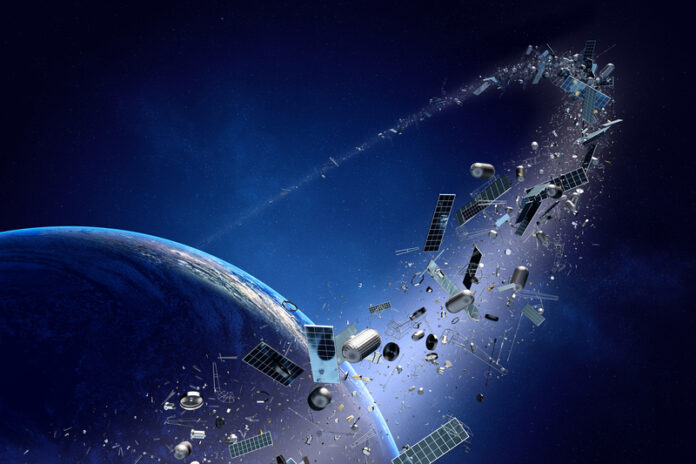In the movie “Contact,” the character Ellie Arroway, played by Jodie Foster, utters the following line when looking to the heavens:
“But I guess I’d say if it is just us… seems like an awful waste of space.”
Based on the number of Starlink satellites being launched each month since the end of last year, plus all the other space companies and government agencies launching satellites, that number has grown by hundreds more as of April 28, 2024, including both operational and non-operational satellites.
That means as of the writing date of this blog, there are at least 12,000 working satellites circling the Earth. Considering that the Space Age began 67 years ago with the launch of Sputnik 1, the skies have become very crowded above our planet with Arroway’s “waste of space” comment becoming less than applicable to our local corner of the Universe.
Some low-Earth orbits are getting crowded, and coveted geosynchronous orbiting slots are quickly disappearing. Defunct satellites in the thousands continue to circle the planet with the potential of these non-working artifacts becoming deadly moving pieces of space junk.
The space insurance industry is reporting record payouts on claims by satellite operators. In 2023, insurers collected US $557 million in premiums and paid out $995 million, a record loss. If this trend continues, insurers will either increase premiums or just get out of the space business.
Satellites are increasingly big and small business opportunities. As of today, 105 countries have at least one satellite in Earth orbit. When in 2010, futurists predicted the democratization of space, they weren’t wrong. The reason for their prognostications was fuelled by:
- the development of reusability in launch vehicles.
- the increasing miniaturization of electronics meaning payloads weigh less.
- the invention of cubesats making it possible for colleges and small businesses to be in the satellite business.
- the use of the International Space Station (ISS) for deploying small satellites.
- the development of piggyback multi-satellite launch capacity.
Since 2020, the vast majority of new satellites are coming in at weights below 600 kilograms (1,320 pounds). The Starlink, OneWeb, Project Kuiper and other telecommunication constellations are driving average weights down. The number of these is expected to grow by as much as 40,000 in the next decade.
And therein lies an enormous problem. Earlier this year NASA reported a near miss between one of its satellites and one from Russia. The two came within 10 metres (33 feet) of each other. This wasn’t an isolated event.
Since the mid-1980s when the space above our planet was far less crowded, there have been space collisions. That’s because many satellites placed in orbit are not built with manoeuvering capabilities. Many others no longer have any onboard fuel for maneuvering, and, finally, many have been put into space without a deorbit plan.
Current methods of monitoring satellites from Earth to avoid collisions remain a challenge. It continues to be a challenge to pinpoint the exact location or trajectory of non-operational satellites or space junk debris. According to Stefan Frey, CEO of Vyoma, a German space traffic management company, the average operator of low-Earth orbit satellites performs two collision avoidance maneuvers per satellite per year. Robert Sproles, the senior director of constellation planning and operations at Spire, a company that builds and operates hundreds of satellites, recently reported his company receives 12 daily close pass and near collision notifications from orbiting space junk and non-operational satellites.
About once a year, the ISS has had to alter its orbit to avoid a collision threat. A recent ISS routine maintenance extravehicular space walk by two Russian cosmonauts included the discarding of used equipment into space. In April, a Florida home was impacted by a discarded pallet of old battery packs from the ISS which proves that throwing out garbage in space has consequences just like it does here on Earth.
Deliberate acts of spacefaring nations have also contributed to space junk. In the mid-1980s both the United States and the Soviet Union tested anti-satellite missile technology. In 2007, China demonstrated this capability. And in 2022 a Russian anti-satellite weapon test struck a dead satellite and produced thousands of pieces of debris. Since 2022 collision risks have risen 50% for satellites deployed between 370 and 570 kilometres (230 and 350 miles) above the Earth because of that one test.
Today, the phrase “waste of space” needs to be turned around. We have a “space waste” problem which the Stuffin Space website adequately illustrates.
What are we doing about the space junk we create?
- Japan recently launched a space junk removal satellite called ADRAS-J.
- The European Space Agency (ESA) has signed a service contract with a Swiss company that is building a satellite called ClearSpace-1 scheduled for launch early in 2025. It will provide a range of in-orbit satellite functions including space junk de-orbiting removal services.
- Space Force, the military arm of the U.S. space program is recruiting and providing project money to companies developing Active Debris Remediation (ADR) technology.
Considering the explosion in the current numbers of near-Earth satellites and what is being forecasted in the near term, developing the capacity to remove the garbage we leave in space cannot come soon enough.
A Postscript
Data from SpaceX on just how crowded low-Earth orbit is getting sheds light on this growing problem. The company recently reported to the U.S. Federal Communications Commission (FCC), that between June 1, 2023, and Nov. 30, 2023, Starlink Network satellites performed 24,410 collision avoidance maneuvers, an equivalent of six maneuvers per spacecraft.
















